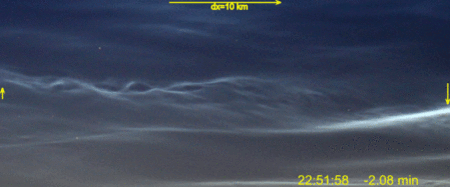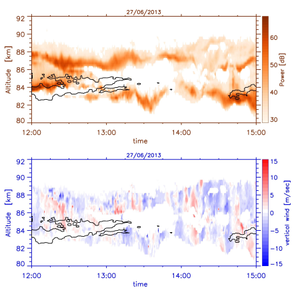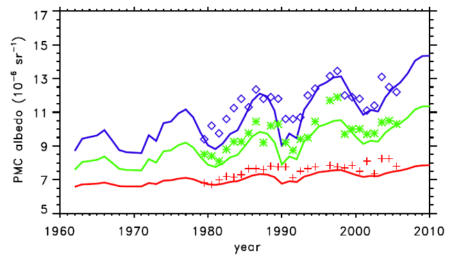Matrix group: PMSE and NLC
In the summer mesopause region (80-90 km altitude) layered phenomena are observed regularly. These noctilucent clouds (NLC) and polar mesospheric summer echoes (PMSE) have been known for several decades and are extensively studied worldwide. Even from space, these clouds are regularly observed and called polar mesospheric clouds (PMC).
Although these phenomena are observed and researched for a long time, the microphysical properties of the constituents are not completely known. In particular, for the creation of PMSE but also the formation of the smallest patricles in NLC, there are conflicting theories. What is known is that both phenomena largely are formed of tiny ice particles that form in the cold summer mesopause region. The formation and the growth of ice depends much on the state of the atmosphere, predominately on temperature and water vapor. Through various remote sensing, in-situ methods and microphysical modeling is demonstrated and understood today that the particles only a few nm to a few 10 nm small. But this also means that they respond quickly and intensively to changes in the atmosphere.
With the combination of observations and models of the three departments of the IAP special aspects of the nature of the layer phenomena are investigated and determined to what extent the observation of ice particles can give information about processes in the atmosphere. How closely NLC and PMSE are connected to each other is seen directly by lidar and radar observations. By these combined observations the relation of ice, charge density and turbulence is investigated. But through the combination of instruments, it is also possible to examine the reasons of the vertical movement of the NLC layer directly. Are these movements direct indications of gravity waves? Once the nature of the changes in the NLC layer is understood, global observations of these clouds by satellite can be better interpreted with regard to gravity waves.
Satellite observations of PMC are in addition used to validate model calculations of changes in the mesopause region, even on time scales of a few decades. These observations of the layered phenomena are the only long term information available from this part of the atmosphere. Through a combination of observation and model, we try to investigate the causes of changes in the middle atmosphere.
















